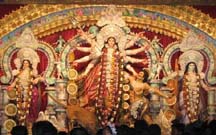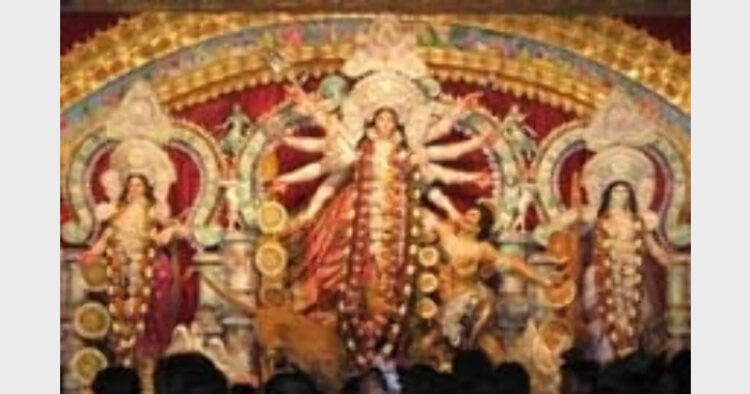 Indian tradition of
Indian tradition of
worshipping women?
Hindu festivals endeavour to emphasise gender equality?
By Dr Surendra Singh Pokharna
Deepavali, Dussehra, Navratri and Durga Puja are some of the main festivals in our country. Deepavali, is the festival of lights and worshipping of Goddess Lakshmi, the deity which brings samruddhi (Prosperity) to the family and the society. Deepavali is also the day on which Bhagwan Sri Ram returned to Ayodhya after winning a war with Ravan, the King of Lanka. Twenty days before Deepavali, Dussehra is celebrated in memory of this war and victory of good over evil.
If we look into details we find that the main cause of the war between Sri Ram and Ravan was due to Sita Mata, who was captured by Ravan by illegal means and who tried to force her to marry him. So Ravan was punished for his misdeeds. Earlier efforts were made by Hanumanji and Vibhishan and others to convince Ravan to return Sitaji to Bhagwan Ram, but Ravan did not listen anybody. A big war then took place between armies of Ram and Ravan in which Ravan was killed. The story has a lesson that those who do not give respect to others women are to be punished by the society. If we go a little back in the past then we find that Dussehra is culmination of Navratri and Durga Puja, the festivals which are being celebrated throughout the country. The nine auspicious nights are devoted to worship Ma Ambe and Ma Durga and are worshipped in many forms and in many ways either through pujas, dances or worshipping through their photos and statues, etc. If we look at these three festivals in totality then we find that deities in form of women are worshipped in all these festivals and somewhere, women prominently comes into the picture.
Although these festivals are purely religious and social functions but in this era of science and technology, it would be quite interesting if we examine the reasoning behind these celebrations in a modern perspective. As deities are worshipped in form of women, it will be interesting to study the impact of these festivals on ordinary women along with probable motive of worshipping women in form of these deities. Here we do not discuss the real deities who are worshipped as God and Goddesses, but only consider effect of celebration of these festivals on men and women. It appears that one can explore methodology of systems sciences to better understand the rationale behind these celebrations. Systems Science is that branch of science where different parts of a system known as sub systems are studied together by taking their interrelations into account, so as to have an integrated view. Such a study could provide new avenues of thought which can provide new insights to many problems of the modern society.
Nine nights of Navratri are nine attributes of a woman. The celebration for nine nights appears to be related to nine phases through which a woman passes through. In Kurma Puran, woman living on the Earth is being equated with the Deity living in the heaven. Hence on the first day, Devi is considered as Shailputri, it is the phase of a woman taking birth. On the second day, Deity is being considered as Brahamacharini that is till her phase of adolescence age. On the third day, Deity is being worshipped as Chandraghanta, a phase till she gets married , (when she is being treated as pure as a Moon). On the fourth day, Deity is worshipped as Kushmanda, it is the phase of pregnancy. On the fifth day, Deity is being worshipped as Skandmata, that is the phase after delivering a child. On the sixth day, Deity is being worshipped as Katyayani, that is the phase in which Deity is being considered as a pious and a highly disciplined woman. On seventh day, Deity is being worshipped as Kalratri, a characteristic of a great Pativrata (a woman completely dedicated to the husband) who wins over unnatural death of herself and her husband. As per Kurma Puran, on the eighth day, Deity is being worshipped as Mahagori, a woman who has goodwill for the whole world. On the last day that is on the ninth day, Deity is being worshipped as Siddhidatri, a role played in which she gives blessings, siddhies and success to the family and the whole world.
When we say that great mahapurushas like Lord Krishna and Lord Mahaveer could see past, present and future at the same time, it means in this context that they could see all nine phases of women at the same time because of a very high order of spiritual development. How does one develop such a balanced view. ? It is through active participation in such religious programmes and understanding the meaning behind them in addition to participating/undertaking similar other religious activities.
The mere fact that Navratri is celebrated for nine nights and emphasis is laid on nine different characteristics of women shows that this festival can be treated as a system in the modern terminology of the systems sciences. A worldly woman is being worshipped for her different roles in her life. It is important to know why these celebrations are held in the night only. This should be contrasted with the fact that other romantic activities with women are also carried out in the night only. The inference is very clear that one should take other aspects of women also into account which are described in Shastras. Actually all the above nine aspects about women should be given equal importance, only then we shall have a balanced and a total view of a woman. That is one must take all phases and the total process into account in which a woman passes through, and to recognise all her attributes in these phases in an integrated (systems) way. Actually women are very close to nature and are most crucial constituents of the life supporting system. Also they have several parapsychic powers like clairvoyance and telepathy, which are more prominent in women than in men. They are also said to have various siddhies and labdhies, hence they are given more importance in the Indian systems of thought. So since women’s intrinsic qualities are more towards spiritual side, they are almost looked upon as Goddesses. They are just not a sexual object alone hence they are being worshipped as Lakshmi, Durga and Saraswati.
It is this balanced view which also makes a male very strong, very rich and very knowledgeable and hence respectable in the society. On the other hand, a womaniser for example cannot not have any good attribute out of these. To have this balanced view, males will have to have high control on their senses. Thus a great brahamchari will have a strong mind and body and will be highly knowledgeable. Also they will probably develop parapsychic powers also like Telepathy and clairvoyance.
Women are also immensely benefitted through such festivals, as they will have more respect in the eyes of men, there will be less crimes against them and so on. Also since women are very close to nature and have a tendency to put everything in an orderly way, once they start getting great deal of respect in the society, they will also try to put more order in the family and the society.
How this balanced view is getting distorted: Males in general have only limited view of women, that is visible in form of physical attributes. What is needed is to have a total functional view of all attributes of them in different phases. Over time, we have stopped realising the wisdom hidden behind these festivals and treat them as just formalities. It is due to lack of this balanced view that crimes against women have increased. Modern film industry, advertising agencies and media have highly distorted this balanced view of the women and have exploited them to run their businesses through cheap marketing of female photographs and female models. Similarly big international industrial groups and MNCs who conduct competitions like ‘Miss Universe’ and ‘Miss World’ etc. have a highly distorted view of women and through money and media have spread this distorted view on a macroscopic scale for their personal gain and using these models to advertise their products.
When World Bank, United Nations and International Monetary Bank and other such agencies carry out a comparative study between men and women in different parts of the world, they also look only at very few attributes of women and recommend solutions taking only economic aspects into account. Many media people have highlighted only such low dimensional solutions of the women’s problems through slogans like ‘Economic Empowerment of women’; ‘Women’s liberalisation Programmes’; ‘Women’s development programmes’; ‘Gender bias’; ‘Inclusive growth’, like attractive terms and concepts, which appear to be due to this limited vision. These solutions are then passed over to our governments and then they are implemented through legalising these ideas. Many of our governments have blindly followed recommendations of such agencies instead of popularising our own cultural programmes which provide better and long lasting solutions, not for women alone but the whole society.
In addition, in the name of imparting education to women, they are also being dragged into a “cut throat competition” in the economic domain. Thus they are studying science, engineering, technology, management and commerce, politics etc, and are diluting their strong areas like art, culture, spirituality, religion, family stability etc., which are their true domains. The current hue and cry over passing of the ‘Women Reservations Bill’ is also questionable. Even if the Bill is passed, it may take very limited dimensions of the women’s characteristics into account, resulting into a huge imbalance in the society.
How to restore back the balances view about women? More extensive social and scientific studies can be further planned out for studying the impact of these festivals on the society in general, family and women in particular. It is most interesting that our ancient forefathers have not only developed such great concepts and ideas, to have a balanced view of women in totality, but have also evolved great practical and pleasant implementation plans which are a source of true happiness. They do not involve much cost also (almost nothing for governments atleast). Celebration of Deepavali, Dussehra and Navratri and such festivals is therefore a major way to give women their due honour and respect. This appears to be one of the major rationale of these festivals that is to have a total systems view of women. The simple concept of ‘economic or political empowerment will serve only limited purpose towards restoring their honour. Let us restore the wisdom hidden behind these festivals.
(The writer is former scientist, ISRO)?













Comments